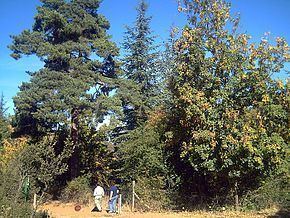 | ||
The Arboretum La Alfaguara was formerly a tree nursery in the Sierra de la Alfaguara, in Alfacar near Granada in Spain. It contains samples of many of the trees that are scattered throughout the Sierra and the surrounding mountain ranges.
Contents
The whole Sierra has been classified as the "Parque Natural Sierra de Huétor". Next to the Arboretum is an entertainment area aimed at schoolchildren in the province of Granada and in Andalusia as a whole. The Arboretum and entertainment area are administered by the Ministry of Environment of the Junta de Andalucía. The Arboretum is about 12 kilometres (7.5 mi) from the capital of Granada, and about four miles from Alfacar. A forest trail starting from Fuente Grande leads into the Sierra de Huétor.
History
For most of the last century the Arboretum was a nursery that supplied mainly coniferous plants for the reforestation of the entire Sierra de Huétor, which had had its original vegetation completely destroyed by over-exploitation for forestry and livestock raising. The Arboretum was opened to the public in 2003 after the grounds, walking trails and information panels of the plants found here were established. In 2005 the Association of Scouts of Andalusia rebuilt the road that runs through the arboretum itself.
Trees and birds
The trees found here are deciduous and evergreen coniferous, intermingled as in the natural environment. There are scientific name labels at the foot of the most significant specimens.
Deciduous trees
Evergreens and conifers
The stars of the Arboretum are several Atlas cedars with trunks 2 metres (6.6 ft) to 3 metres (9.8 ft) in diameter, under whose canopy there is a thick formation of seedlings.
Birds
Many birds nest is the Arboretum such as:
Facilities
Facilities in the Arboretum include:
